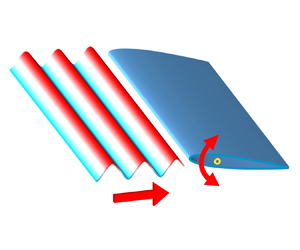Article contents
Combined Theodorsen and Sears theory: experimental validation and modification
Published online by Cambridge University Press: 30 April 2024
Abstract

The response of airfoils to unsteady disturbances is a classic problem in the aerodynamics field. Many theoretical models have been proposed in the past to predict the unsteady aerodynamic forces of airfoils. However, these theories focused on individual airfoil motions or incoming flow disturbances, while the theoretical models for multiple disturbances still need to be developed. In this study, a theoretical model to predict the aerodynamic force of an oscillating airfoil encountering vertical gust is derived from a linear combination of Theodorsen's and Sears’ theories. Experimental investigations involving a two-dimensional pitching airfoil encountering a sinusoidal vertical gust are carried out to examine the proposed theory. It is found that the theory effectively captures the trends in the unsteady lift of airfoils subjected to dual disturbances. However, it tends to overestimate the lift amplitude. Notably, when a quasi-steady correction is applied to the theory, the prediction accuracy is greatly improved. The theory correction agrees well with experiment at small pitching frequencies, while deviations exist at higher pitching frequencies. The temporal evolution of the flow velocity reveals that the velocity disturbance induced by the coupled disturbance around the airfoil conforms to the linear superposition of the velocities induced by each individual disturbance, consistent with the prediction of the vortex sheet model. As the pitching frequency increases, significant nonlinear effects appear near the trailing edge of the airfoil, which may be one key factor for the disparities between the theoretical predictions and the experimental lift at higher pitching frequencies.
JFM classification
Information
- Type
- JFM Papers
- Information
- Copyright
- © The Author(s), 2024. Published by Cambridge University Press
References
- 4
- Cited by


